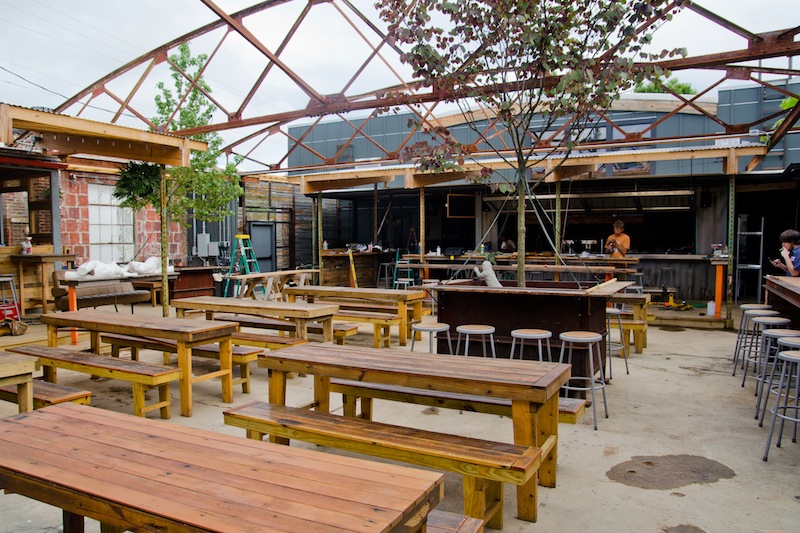Ben’s Tune-Up has forged, perhaps, the first link between ‘60s Japanese rock, crystals, taxidermy, Chia Pets and the auto-repair industry.
Those elements play into the atmosphere at the restaurant, which opens Tuesday, June 25, on Hilliard Avenue. The food has its own set of idiosyncrasies.
“I like to see people having a good time,” says Jonathan Robinson, one of the restaurant’s four owners. “I was always the kid who threw the parties when I was in high school.”
The hybrid business (restaurant, bar, sake brewery and more) is set up for a party. In fact, it’s a party fortress. The high, cinderblock walls and metal fencing that surround the indoor/outdoor restaurant give it an industrial castle vibe.
The entry opens onto a wide courtyard, where a living wall softens the space; reclaimed wood gives the old concrete and metal a warm feel; homemade Chia Pets gaze at one another whimsically. In the courtyard and the cozy bar/dining room inside, there’s room for 250 people to hang out and discover what the place is all about.
Carpenters and co-owners Meg Alt and Molly Clark brought the building back from the brink. The build-out, which they completed mostly by hand, deserves a newspaper story of its own. “They definitely had a vision for this place, and I was lucky to meet them at the right time,” Robinson says.
“We’re doing a bunch of fun shit here,” says Elliott Moss, chef and part-owner. “ I think this is uniquely Asheville. We all live here. We all love it. This is the vision we have, and hopefully everyone digs it. If they do, then we did our job.”
Moss left The Admiral earlier this year to focus on Ben’s Tune-Up and his forthcoming Southern restaurant, Buxton Hill (in which he’s also partners with Robinson). He led the culinary crew at The Admiral since it opened in 2007.
But now, he says, he feels like he’s a chef for the first time. In the kitchen of Ben’s Tune-Up, he handles his ingredients reverently: the house-made ramen (and macaroni) noodles, the steaks of Japanese Amberjack flown in by Honolulu Seafood Company a day or so before, even a long rectangle of American cheese, which he has made himself.
“This is somewhere I would want to come hang out,” Moss says.
Think of the food at Ben’s Tune-Up as sakana, Japanese pub fare, the kind found in izakayas, casual drinking establishments. Accordingly, the menu features yakitori — grilled meat skewers — sashimi and pickles. The small portions are priced a la carte at about $5 to $10 apiece, and meant to be ordered in multiples and shared. “Typically, you order yakitori, it’s just a skewer,” Moss says. “This is more of a composed dish, but an ultra-micro version. You get your stick of meat, but you get a little dab of this, a little dab of that.”
Think of it as a noodle shop: heaping bowls of ramen — featuring house-made noodles and pork broth — offer a more decadent option. “If you want to get full for $10, you can get a bowl of ramen,” Moss says.
Think of it as a American-style yoshoku restaurant. In Japan, yoshokus serve interpretations of Western fare that have developed over more than a century, such as hambagoo and Napolitan spaghetti (which are related to the dishes they sound like, but only somewhat). While you might not see those particular dishes at Ben’s Tune-Up, Moss will serve up plenty of katsu sandos — breaded chicken sandwiches with American cheese and white bread. “That’s just going to be our bar drunk snack, or for the picky eaters, or for the kids, and it’s going to taste like a really good chicken sandwich,” he says.
Since the late 19th century, Western food has been interpreted by the Japanese and transformed into something completely different. At Ben’s Tune-Up, Moss will add another level of interpretation to the mix.
Ben’s Tune-Up plays off the twisted nature of the yoshuku, in its cuisine and in its overall design: The name of the auto-repair shop that used to occupy the building lives on. Pictures of Japanese rock-and-rollers from the ‘60s hang in the bathrooms. The taxidermy animals make strange cousins to the chia-seeded critters outside. A Liberace-style chandelier hangs from the dining room ceiling. The restaurant’s flare skirts the bizarre and avoids nostalgia. Influences from the past are clearly in the grip of a fresh ideas.
“People want to be surprised,” Moss says.





“The restaurant